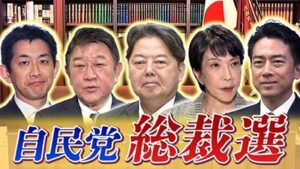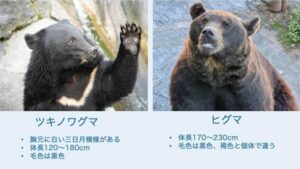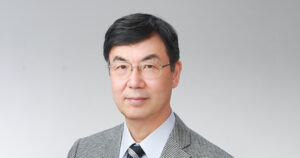
スウェーデンのカロリンスカ研究所は、坂口志文・大阪大学栄誉教授(74)ら日米3氏にノーベル生理学・医学賞を贈ると発表しました。(10月7日)
Japanese scientist Sakaguchi Shimon is one of three winners of this year's Nobel Prize in Physiology or Medicine.
※受賞者:recipient/laureate
滋賀出身でのんびりとした環境に育ち、京大医学部に進学。アメリカで免疫学を学ばれました。
A native of Shiga Prefecture, Sakaguchi grew up in an easy-going environment, enjoying reading various kinds of books from his childhood. After studying at Shiga Prefectural Nagahamakita High School, he advanced to Kyoto University’s Faculty of Medicine, where he became interested in diseases involving the immune system. He then studied immunology at Johns Hopkins University in the United States.
※native~生まれの人
※easy-goingのんびりした、おおらかな
※immunology 免疫学
過剰な免疫反応を抑制するブレーキ役となる「制御性T細胞」を発見。
He discovered regulatory T cells in 1995, which are necessary for suppression of overreaction to self-produced antigens and suppression of allergic responses.
※suppression抑えること、抑圧、抑制、鎮圧
※antigen《免疫》抗原(生体内に入って抗体=antibody)を生成する作用のある物質
免疫は強めるものだという本流の考えの中、独自路線を貫き、一匹おおかみとみられていたということです。
Sakaguchi had been viewed as a maverick researcher.
※maverick ①所有者を示す焼き印のない放牧牛②独自路線を行く人、一匹おおかみ
While many other researchers sought ways to strengthen the immune system, his research centered on suppressing immune responses. Although many disagreed with his hypothesis, Sakaguchi persevered with his research.
※hypothesis仮説
※persevereやり抜く、頑張り通す
今後、自己免疫疾患やがんの治療などにつながることが期待されます。
There is hope that his achievements will be applied to the treatment and prevention of human immune disorders.
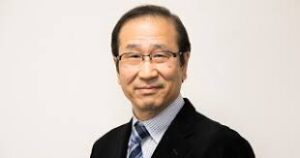
その二日後、スウェーデンの王立科学アカデミーが、ノーベル化学賞を、京都大学の北川進特別教授(74)と豪と米の3人に贈ると発表。多孔性金属錯体(MOF)の開発による栄誉です。気体の貯蔵が可能で、応用に広い可能性を秘めています。
Japanese scientist Kitagawa Susumu is one of the three winners of this year's Nobel Prize in Chemistry for creating molecular constructions, called metal-organic frameworks. Kitagawa’s award-winning MOFs are materials filled with countless tiny, orderly pores. These structures can absorb a wide variety of gases, making them useful in both industrial and environmental applications.
※pore孔、毛穴、気孔、隙間 別のpore:じっくり見る、熟読、熟考する
※orderlyきちんとした、整然とした
発見当初は、批判も受けましたが、やり遂げられました。
When Kitagawa presented his findings in 1999, he faced strong criticism from international researchers. The substance he discovered was an organic compound bonded to a metal, which was then considered too unstable for practical use. Nevertheless, Kitagawa did not yield to the criticism and persisted with his research.
※yield屈する ※persist 辛抱強く~しずつける、貫く
京大時代に読まれた本の中に、物理学者、湯川博士が荘子の「無用の用」(役に立たないように見えても、実は大きな価値がある)を紹介されており、それが座右の銘だとのことです。
In books by famed physicist Hideki Yukawa, Kitagawa was captivated by the Lao-Zhuang philosophical concept of “muyo-no-yo” (the usefulness of the useless), the idea that things that appear to have no purpose are, in fact, useful.
※physicist物理学者
※captivate魅了する
平穏な時にこそ、アイディアが浮かぶと言われています。
Chemistry Nobel winner Kitagawa says downtime helped him think up new material (見出し)
※downtime:(労働者や機械の)作業中止時間、(美容整形)腫れが落ち着く時間 ➾リラックスできる時間
“It’s in the quiet moments that various ideas come to me. ”
➾epiphany ①キリスト教:公現日:東方の3博士の訪れ ② 〔真理等についての〕突然のひらめき、悟り
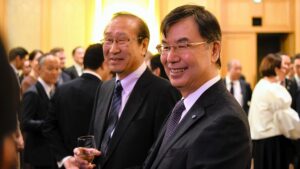
同じ年の特別教授のお二人が、レセプションで顔を合わせられました。
The two Japanese Nobel laureates attended a reception for Swedish Crown Princess Victoria hosted by the Swedish Embassy in Tokyo on Monday evening.(10/14)
・名誉教授a professor emeritusは退職した元教員に与えられる栄誉称号で、職務や報酬はありません。
「特別教授」「特別栄誉教授」distinguished professor は、現役の教授の上位に位置づけられる職階であり、特定の功績が認められた教授に与えられます。

